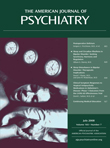Increased Anxiety During Anticipation of Unpredictable But Not Predictable Aversive Stimuli as a Psychophysiologic Marker of Panic Disorder
Abstract
Objective: Predictability is a fundamental modulator of anxiety in that the ability to predict aversive events mitigates anxious responses. In panic disorder, persistent symptoms of anxiety are caused by anticipation of the next uncued (unpredictable) panic attack. The authors tested the hypothesis that elevated anxious reactivity, specifically toward unpredictable aversive events, is a psychophysiological correlate of panic disorder. Method: Participants were exposed to one condition in which predictable aversive stimuli were signaled by a cue, a second condition in which aversive stimuli were administered unpredictably, and a third condition in which no aversive stimuli were anticipated. Startle was used to assess anxious responses to cues and contexts. Results: Relative to healthy comparison subjects, patients with panic disorder displayed equivalent levels of fear-potentiated startle to the threat cue but elevated startle potentiation in the context of the unpredictable condition. Conclusions: Patients with panic disorder are overly sensitive to unpredictable aversive events. This vulnerability could be either a premorbid trait marker of the disorder or an acquired condition caused by the experience of uncued panic attacks. As a premorbid trait, vulnerability to unpredictability could be etiologically related to panic disorder by sensitizing an individual to danger, ultimately leading to intense fear/alarm responses to mild threats. As an acquired characteristic, such vulnerability could contribute to the maintenance and worsening of panic disorder symptoms by increasing anticipatory anxiety.



